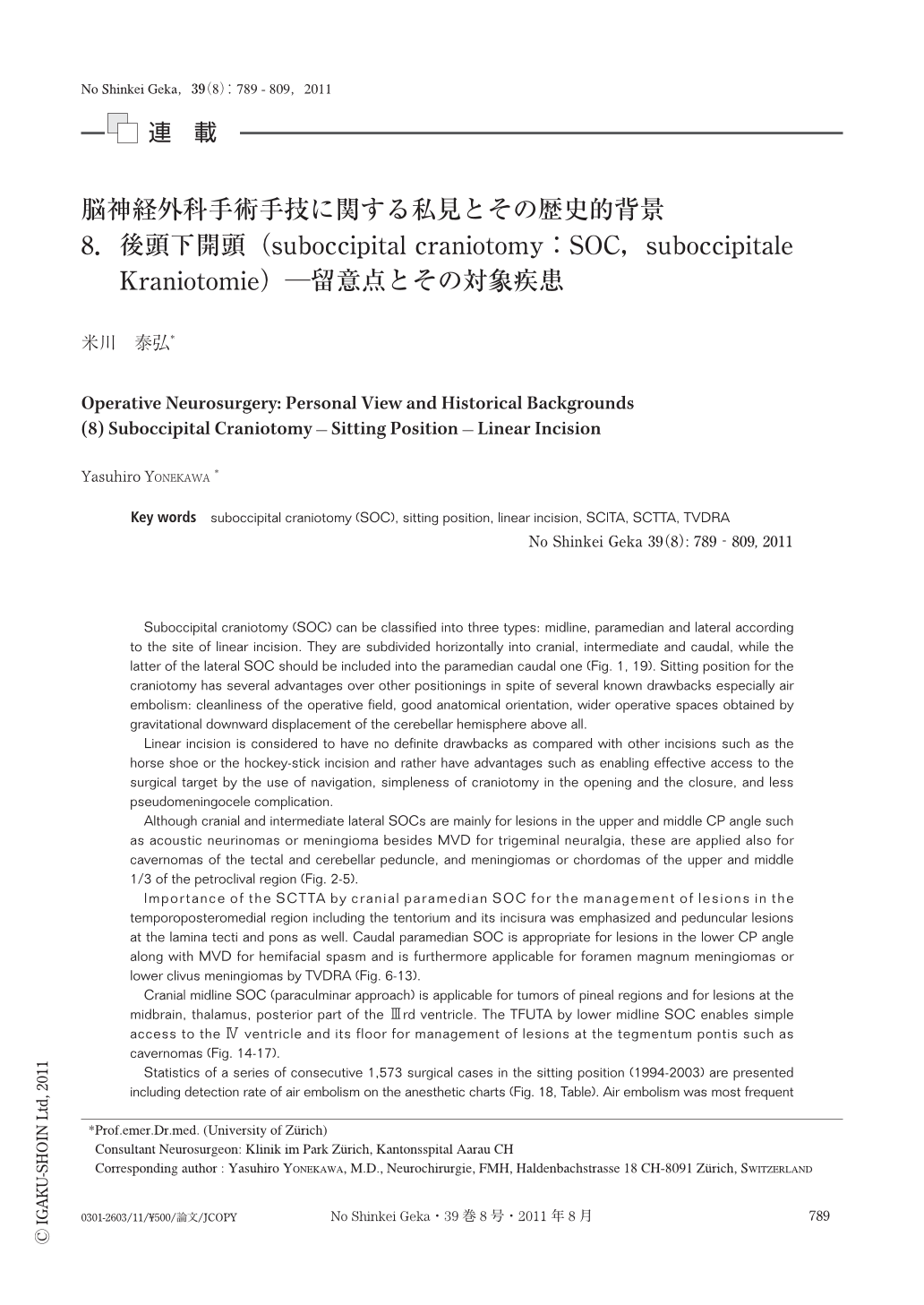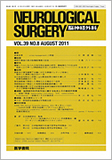Japanese
English
- 有料閲覧
- Abstract 文献概要
- 1ページ目 Look Inside
- 参考文献 Reference
Ⅰ.はじめに
「Suboccipital craniotomy(SOC)―sitting position―linear incision」と判じ物のような英文タイトルになったが,それが今回のテーマである.Zürich大学病院に1993年に着任して以来,このテーマに関しては聴神経腫瘍(acoustic neurinoma,Akustikusneurinoma)を第1例としてSOCを座位,linear incision(線状切開,lineäre Inzision)で行い,定年退官直前の2007年5月末に878回目のSOCを同じく座位,linear incision,paramedian supracerebellar transtentorial (SCTT) approachによるoccipital artery-superior cerebellar artery(OA-SCA)bypassで終えた19).ちなみに,このSOCという用語はあまり用いず,当科ではかつてKleinhirnexplorationというのが一般のSOCに用いられていた.1970年初頭頃に骨弁をSOCでも整復するようになった. 聴神経腫瘍に対する開頭としては,retroauriculäre retromastoidale osteoplastische Kraniotomieというのが当科初代のProf.Krayenbühl,その後継者Prof.Yaşargil以来使われてきた用語である.この用語のほか,近年はsuboccipitale osteoplastische Kraniotomieの名称のもとに,これに,mediane,paramedianeをつけて用いている.したがって前記の聴神経腫瘍用の開頭はlaterale suboccipitale osteoplastisch Kraniotomieということになるが,この名称はあまり使っていない.
手元に医学書院の『解剖を中心とした脳神経手術手技(1999年版)』10)があるが,その中でSOCに頻用されている馬蹄形,hockey-stick,Hokeystockの皮切は用いず,もっぱらlinear incisionを行っているが,この方法で不都合を経験したことがない.Linear incisionの利点は,対象物のorientationに関して最近頻用されるnavigationを利用しやすい,開頭,閉頭が簡単迅速にできる,術後のpseudomeningocele,Liquorkissenの合併症がまずないということなどである.また,画像診断技術,navigationの発達で,開頭骨弁が4~5cm以下で済むようになったことにもよる.
これまで述べてきている脳深部のstructuresの局所解剖を理解して手術を進めるには,経験の積み重ねがいる.空気塞栓(air embolism,Luftembolie:LE)などのいくつかの欠点はあるものの,座位手術そのものがSOCに際して側臥位,腹臥位手術に比べるとはるかに解剖学的orientationをつけやすいことはその大きな利点の1つでもある21,23).聴神経腫瘍のように比較的頻繁にみられる疾患では,解剖学的所見位置に慣れているので頭部を20~30度回転した頭位が術野の正面の病変の扱いには便利であるが,比較的稀な疾患,慣れない病変では頭位を正中にした座位手術のほうが解剖学的なorientationがさらにつけやすいことも,Prof.Malisの言を引用して既に本連載でも述べ,討論してきた22).本稿では,後頭蓋窩,およびthalamus,midbrain側頭葉内側後方に所在する病変の位置に対応してのlinear incisionでの座位手術について,私の手術経験例を集約し分析を試みるが,読者諸兄の日常の手術施行の参考になれば幸いである.Fig. 1に示すごとく,SOCをlateral,paramedian,midlineに分け,さらに各々を水平面でcranial,intermediate,caudalに分け,討論解説を試みる.
Suboccipital craniotomy (SOC) can be classified into three types: midline,paramedian and lateral according to the site of linear incision. They are subdivided horizontally into cranial,intermediate and caudal,while the latter of the lateral SOC should be included into the paramedian caudal one (Fig. 1,19). Sitting position for the craniotomy has several advantages over other positionings in spite of several known drawbacks especially air embolism: cleanliness of the operative field,good anatomical orientation,wider operative spaces obtained by gravitational downward displacement of the cerebellar hemisphere above all.
Linear incision is considered to have no definite drawbacks as compared with other incisions such as the horse shoe or the hockey-stick incision and rather have advantages such as enabling effective access to the surgical target by the use of navigation, simpleness of craniotomy in the opening and the closure, and less pseudomeningocele complication.
Although cranial and intermediate lateral SOCs are mainly for lesions in the upper and middle CP angle such as acoustic neurinomas or meningioma besides MVD for trigeminal neuralgia, these are applied also for cavernomas of the tectal and cerebellar peduncle, and meningiomas or chordomas of the upper and middle 1/3 of the petroclival region (Fig. 2-5).
Importance of the SCTTA by cranial paramedian SOC for the management of lesions in the temporoposteromedial region including the tentorium and its incisura was emphasized and peduncular lesions at the lamina tecti and pons as well. Caudal paramedian SOC is appropriate for lesions in the lower CP angle along with MVD for hemifacial spasm and is furthermore applicable for foramen magnum meningiomas or lower clivus meningiomas by TVDRA (Fig. 6-13).
Cranial midline SOC (paraculminar approach) is applicable for tumors of pineal regions and for lesions at the midbrain, thalamus, posterior part of the Ⅲrd ventricle. The TFUTA by lower midline SOC enables simple access to the Ⅳ ventricle and its floor for management of lesions at the tegmentum pontis such as cavernomas (Fig. 14-17).
Statistics of a series of consecutive 1,573 surgical cases in the sitting position (1994-2003) are presented including detection rate of air embolism on the anesthetic charts (Fig. 18,Table). Air embolism was most frequent (21%) in the lateral SOC as compared with other SOCs (8.8% on the average). This happened during the extradural procedures in 80% and in 20% in the intradural procedures. Some important technical managements of bridging veins,venous plexus and cerebellar retraction are discussed in carrying out the SOCs.

Copyright © 2011, Igaku-Shoin Ltd. All rights reserved.


